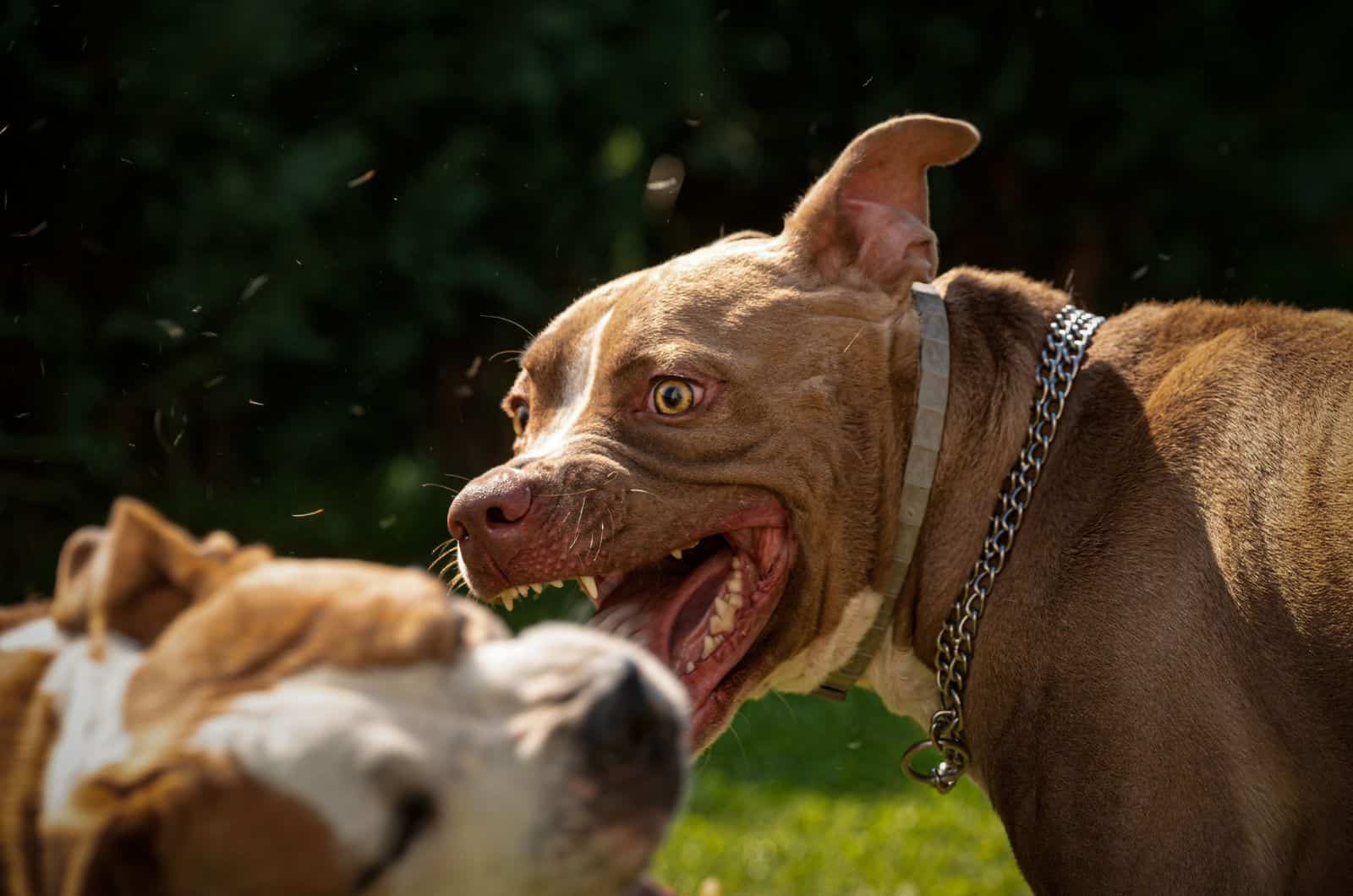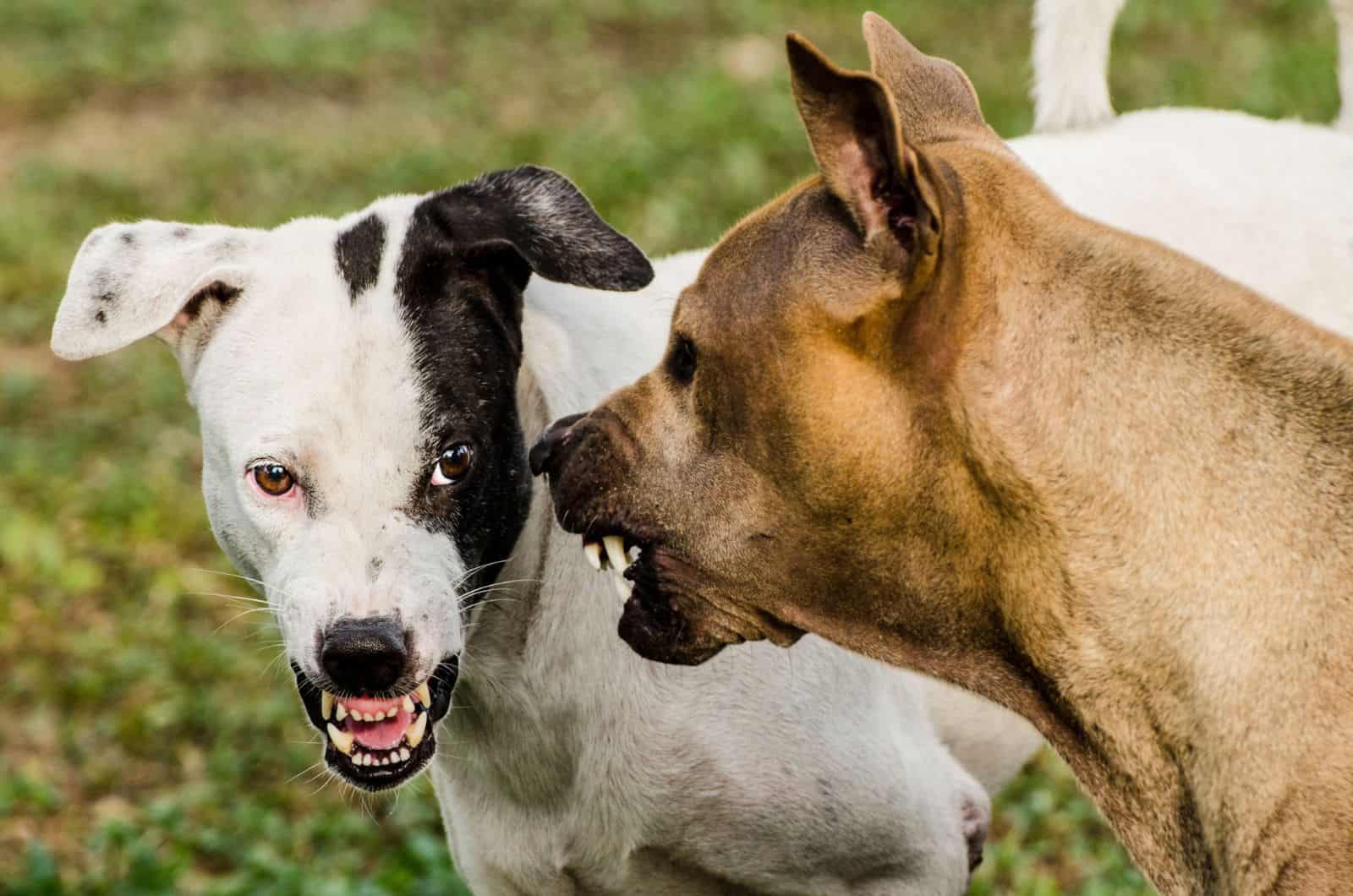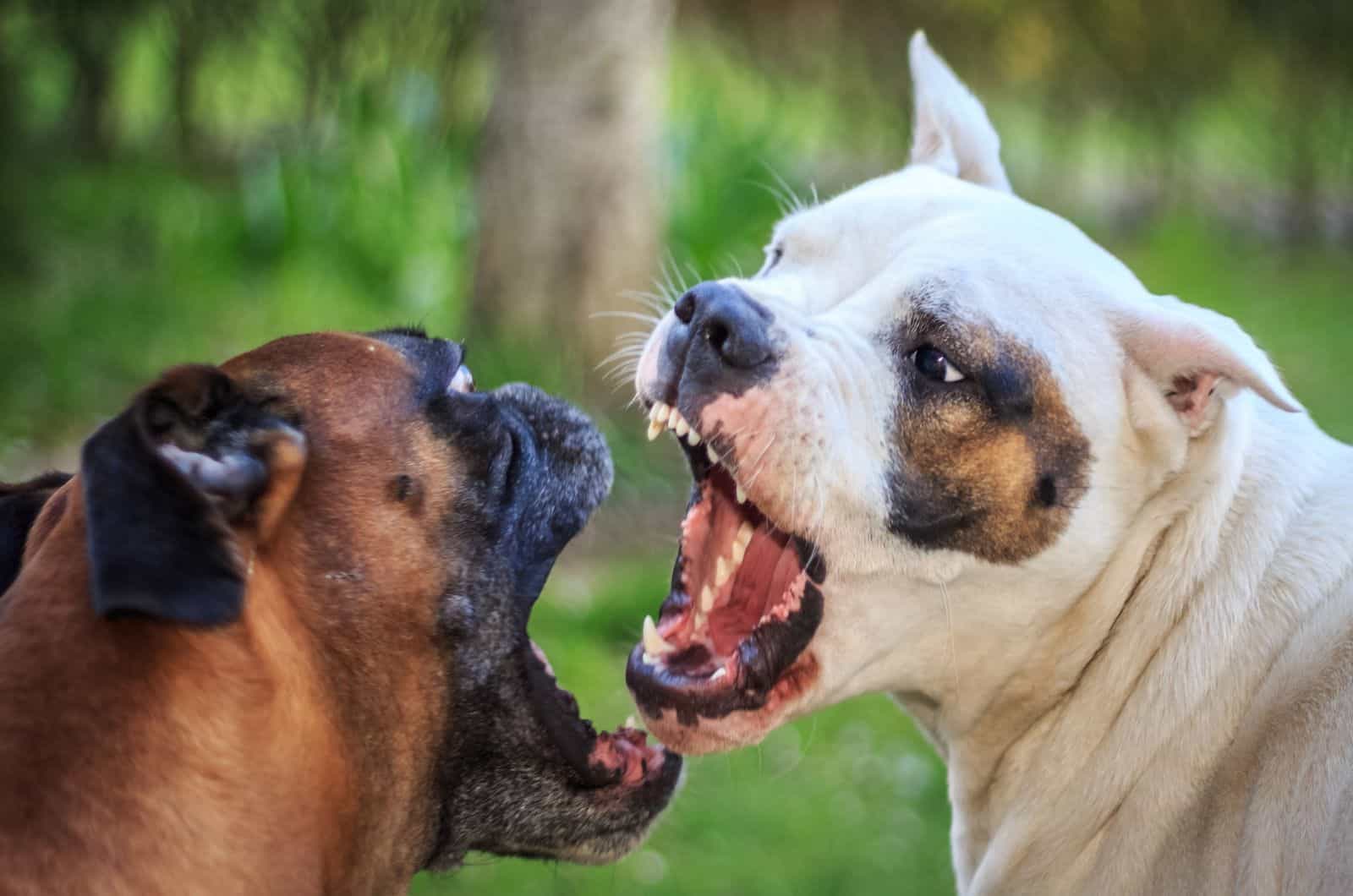Warning. This article contains sensitive content—reader discretion is advised.
Disclaimer—we do not condone dog fighting, the use of bait dogs, or any other form of animal cruelty, this article is simply meant to be informational and to raise awareness about the topic of animal cruelty.
If you’re looking for an answer to the question: “What is a bait dog?”, you’re likely also wondering if they’re real or just an urban myth.
Sadly, thousands of dogs around the world are abused in many different ways on a daily basis, and being used as bait is one of these ways—the unfortunate truth is that bait dogs do exist, albeit, they’re not as common as you might think.
With that in mind, let’s explain what a bait dog is, how to recognize one, and what to do if you suspect that a specific dog has been abused in any way.
What Is A Bait Dog?

The term bait dog or bait animal is used in underground dogfighting circles to refer to animals who are usually chained to a wall, deliberately malnourished, and incapacitated by having their muzzle taped shut in order to be used as bait for training fighting dogs.
However, the term is also used interchangeably to refer to dogs that are abused in general—the actual origin of the term bait dog comes from a 1996 article published by the New York Times Union, where it was used to describe dogs that were tied up and abused by their owners.
The sad truth is that bait dogs are not just a myth and are indeed a real thing—and the people who abuse dogs and other animals are often involved in several other forms of crime, ranging from domestic abuse to gun-running, drug trafficking, and other forms of organized crime.
Unfortunately, due to the widespread appeal of illegal dog fighting rings (both street-level and in professional circles), the people who profit from breeding, kidnapping, training, and fighting dogs are often discrete in their operations—and due to only the most obvious and most shocking cases being reported, few are ever prosecuted.
What Is The Purpose Of A Bait Dog?
The purpose of a bait dog is to condition a fighting dog to become more aggressive by providing it with a proverbial punching bag—that way, it’ll be more willing to attack and be even more ferocious when it’s placed in the fighting pit.
‘Bait dogs’ are often tied with heavy chains and have their muzzle taped shut so that the ”game dog” can maul its defenseless opponent without the risk of being injured during ‘training’.
The idea behind this is that providing a game dog with an easy opponent to practice on will make it better at fighting—while in reality, no amount of attacking a defenseless dog is going to increase the fighting skill of a fighting dog and only perpetuates the suffering of both parties involved.
How Do People Acquire Bait Dogs?
Dogfighting trainers can acquire a bait dog in several different ways.
From picking up stray dogs on the street, adopting dogs from shelters, or buying them on Craigslist to dog-napping canines that are left unsupervised, or even breeding their own dogs—people are easily able to get their hands on dogs to use as bait dogs.
Sadly, most dogs that are procured this way are then severely mistreated and end up being left alone and helpless out on the street—that’s why so many cases of abused dogs are handled daily by rescue organizations like the ASPCA.
If you suspect that a certain dog has been abused or mistreated in any way, shape, or form—the best thing you can do to help out is to contact your local law enforcement and report the issue.
Which Dogs Are Most Often Used As Bait Dogs?

Now that we’ve answered the question: “What is a bait dog?”, it’s time to explain which dog breeds are usually used as bait dogs.
Unfortunately, any type of dog can become a bait dog—from small dog breeds to medium-sized and large dogs, no dog breed is safe from being used as a bait dog.
The dogs that are most often used as bait dogs are ones that tend to be more submissive, docile, and lack a fighting instinct—but there are also cases of more aggressive breeds, like Dobermans and Pitbulls, being used as bait dogs.
Sometimes, trainers will also use cats or other small animals as bait if there are no dogs available—but the statistics of cases reported show that American Pit Bull Terriers are the go-to breed for both dog fighting and dog baiting.
Unfortunately, Pitbull dogs and Pitbull-like dogs are most often used as fighting dogs—and the harsh reality is that dogs that are forced to fight are also victims themselves, alongside the dogs that are used as bait dogs.
Animal fighting, in general, is a horrific practice that should be eradicated—but the fact remains that it’s difficult to catch, prosecute, and convict people for dogfighting.
Being a highly secretive practice, dogfighting is often difficult to infiltrate by law enforcement forces—the resources and skills required, along with the challenges that undercover officers face in underground dogfighting circles, are very similar to major narcotics investigations.
Another complication that inhibits the prosecution of dogfighting cases is the amount of animal care and human resources required for such a process, which are unfortunately not nearly enough to eradicate dogfighting in its entirety.
Are Bait Dogs Even Effective?
Now that you know the answer to the question: “What is a bait dog?”, another valid question that still remains is whether or not bait dogs are an effective means of training fighting dogs at all.
Experts believe that bait dogs are an extremely ineffective way of training fighting dogs—in fact, most experts believe that it’s counterintuitive.
If you think about it, even a human fighter that’s training to fight against a weak and incapacitated opponent will never yield good results—likewise, fighting dogs are unlikely to get better and stronger at street fights by being pitted against weaker opponents during training.
In fact, dogfighting trainers often employ dog training tactics that are more similar to training human athletes—they often use weighted vests and treadmills to raise a dog’s stamina levels and increase their overall strength.
However, one important thing to note is that these training methods are legitimate ways of keeping a dog in shape and that the use of treadmills and weighted tires doesn’t necessarily mean that a dog is being trained for dog fighting.
How Can You Tell If A Dog Was A Bait Dog?

A potential sign that a particular dog has been used as a bait dog is if the dog has cropped ears and a docked tail, although this is not a rule of thumb and every case should be approached individually—some dog owners simply prefer the cropped and docked look.
However, dog breeds that are most often cropped and docked because of dogfighting are Pitbulls—while ear cropping in breeds like the Cane Corso is more often a dog owner’s personal preference.
Bait dogs often have several identifiable physical signs of being abused—you should look for scars, lacerations, broken bones, loss of blood, and puncture wounds on the dog’s face, ears, chest, and legs, since these are the areas where dogs are most often injured during dog fights.
The breeds that are most often used as both bait dogs and as fighting dogs are Pitbulls, Dogo Argentinos, Fila Brasileiros, and Presa Canarios.
Most often, bait dogs don’t have their injuries tended to, so if you see a malnourished dog with extensive scarring or injuries across their body and they act fearful or even aggressive—these might be clear signs that the dog was used as a bait dog.
Are Bait Dogs Dangerous To Keep As Pets?
A lot of people out there might want to provide abused dogs with a new home and a second chance at a normal life and you might be one of them—but it’s also normal to be a bit apprehensive. Since these dogs were mistreated so badly, you might think that a bait dog will be aggressive toward you or members of your family.
While this may be true in some cases, all dogs are individuals and therefore, each case should be judged individually—some younger dogs might attack older dogs for several different reasons that have nothing to do with being used as bait dogs or fighting dogs.
Most dogs that have been abused are safe to keep as family pets with the right approach—care, attention, love, and supervision are key to turning a former bait dog into a loving family dog.
When rehabilitated, a dog might still bite another dog’s neck or appear to be aggressive while playing, but more often, this is not a reason for concern if there’s no real aggression present.
It’s worth noting that some bait dogs are able to integrate well with humans but can be a bit aggressive toward other pets in the household—that’s why preparation, researching how to socialize an aggressive dog, and hiring a dog trainer are the best ways to rehabilitate a former bait dog and turn it into a sweet family companion.
The same goes for dogs that were used as fighting dogs—just because a dog was trained to be a merciless attack dog and was abused for god knows how long, doesn’t mean that it can’t turn into a loving pet with the right approach.
Fighting dogs are just like any other dogs, and deserve another chance at a normal life—albeit, if you want to adopt a former fighting dog, it’s best to enlist the help of a professional dog trainer and spend more time with the dog in order to reform its behavior.
One useful thing to always keep close by is a dog tail position chart—it’s basically a cheat sheet for figuring out how your dog is feeling at any given moment, and it comes in especially handy for owners who adopt a formerly abused dog.
The 411 On Dogfighting
There are several different reasons why people are drawn to dogfighting—but the most often seen reason is that it brings in a lot of money.
It’s not uncommon for $20,000 to $30,000 to change hands in a single underground dogfight, and some dogfight raids have even resulted in seizures of over $500,000.
Another way dogfighting trainers can earn lots of money is by selling puppies from promising bloodlines or providing stud services for other trainers, earning them thousands of dollars.
Needless to say, Dogfighting and dog baiting are forms of animal abuse and are considered felony offenses in all 50 states—they are punishable by up to three years in prison and up to a $250,000 fine.
Of course, dogfighting is a blood sport that’s been around for centuries and its origins can be traced back to ancient Rome, where it was considered entertainment to pit dogs to fight against bait animals such as bulls or bears.
Today, dog baiting and dog fighting are illegal in most countries, except for a handful of places such as Japan, Honduras, Albania, and parts of Russia, where they still openly occur.
Sadly, even in countries that have outlawed it and have strict regulations in place against it, the cruel practice of dog fighting is still perpetuated in underground circles.
A lot of people are into dogfighting these days and a lot of them have been caught, prosecuted, and convicted for running or participating in illegal dog fighting—one high-profile case that you might have heard of was former NFL quarterback Michael Vick, who was convicted of running an underground dogfighting ring back in 2007.
Vick was sentenced to 23 months in federal prison but ended up serving only 18 months before he was released.
How To Spot The Signs Of Dog Fighting In Your Community

If you’re an upstanding citizen and you want to do all that you can to help keep your local community safe and secure, you might be wondering how to spot the signs of a dogfighting organization and what you can do to prevent it.
One potential sign that could indicate that a dog is being trained as a fighting dog or used as a bait dog is an unusual amount of Pitbull-type dogs being kept together in one location, especially if the dogs are chained with heavy chains and appear unsocialized or aggressive.
Some other clear signs are if you see any dog that has scars on its face, chest, or legs, or any unusual amount of dogfighting training equipment, such as treadmills, spring poles, and break sticks.
Another surefire way to tell that someone is participating in dogfighting is if you see that they receive an unusual amount of strangers visiting them at odd hours.
If you do suspect that someone in your community is participating in dogfighting, the best way to help is to report the case to your local law enforcement and let the professionals take it from there.
In Conclusion
So, now that we’ve answered the question: “What is a bait dog?”, you’re likely to be more familiar with the term and all that it entails.
Unfortunately, thousands of dogs are put through hard times on a daily basis, and being used as bait dogs is one such way—so, don’t let anyone tell you that they’re not a real thing.
Remember that people who participate in dogfighting are dangerous and are almost always involved in other forms of crime. Therefore, you should never act on your own and try to infiltrate or confront a suspected animal abuser—the best thing you can do to help animals that you think are abused, is contact your local law enforcement and let them take care of it.















